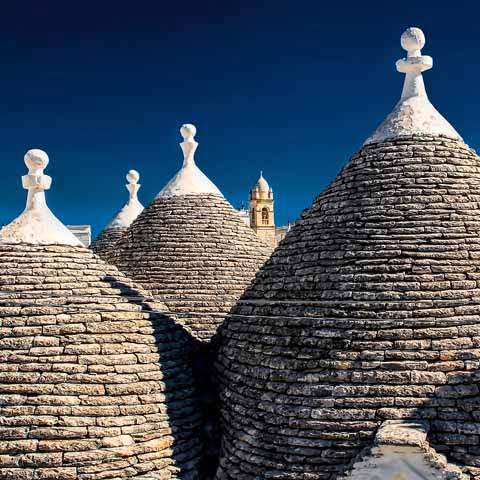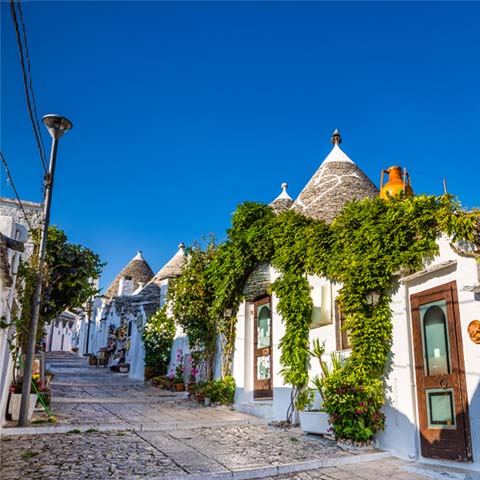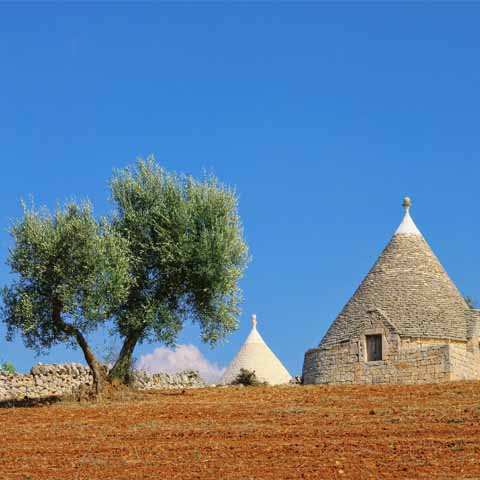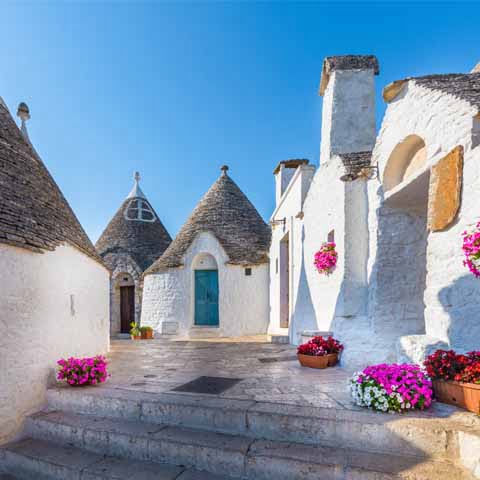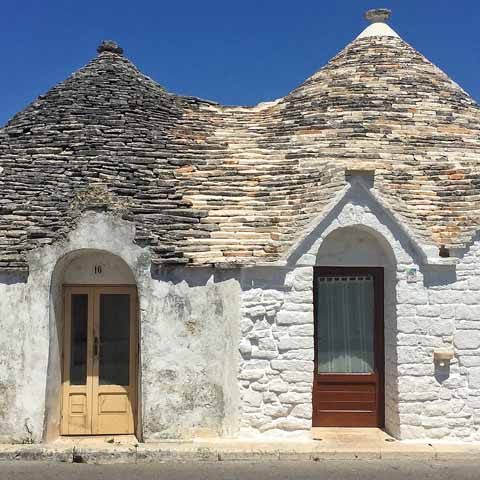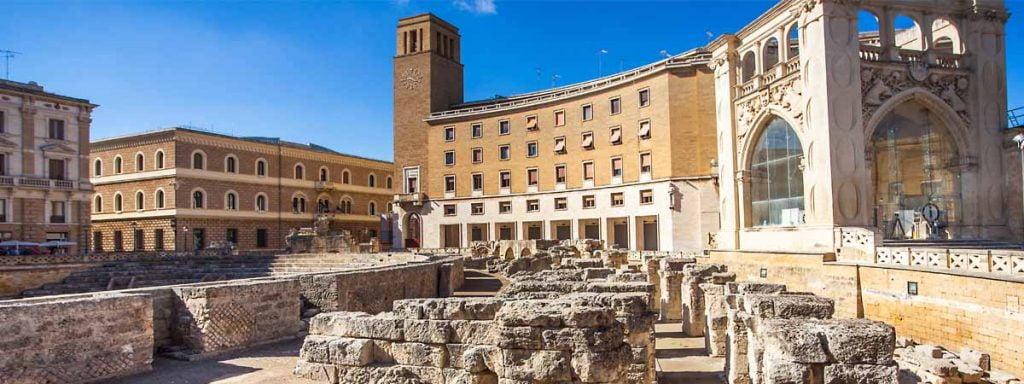Alberobello is a small Italian town located in the metropolitan city of Bari, in the middle of the Itria Valley and Terra dei Trulli.
Terra dei Trulli refers to a stretch of territory that extends between Terra di Bari and Salento, consisting of thirteen municipalities located in three different provinces. Alberobello, Noci, Locorotondo, Castellana Grotte, Polignano a Mare, Monopoli, Putignano and Conversano are in the metropolitan city of Bari; Fasano, Ceglie Messapica, Cisternino, and Ostuni in the province of Brindisi, and Martina Franca in the province of Taranto.
This small settlement is home to roughly 11,000 people and is one of the most original places to visit in Italy thanks to the peculiar dwellings that characterize the landscape, the Trulli. Alberobello is famous for these characteristic houses and, since 1996, the town is a UNESCO World Heritage site.
But despite its prehistoric aspect, Alberobello was only officially founded in the fifteenth century AD on an uninhabited territory in the middle of a woodland. In fact, it is believed that the name Alberobello derives from the Latin sylva arboris belli, which roughly translates to “the wood of the beautiful trees.” Although not all historians agree on the origin of the name, they do agree on the fact that the territory was a forsaken land before it was assigned to the Counts of Conversano.
PREHISTORY OF ALBEROBELLO
Although there is not prehistoric evidence of human presence on today’s territory of Alberobello, Apulia was inhabited since the earliest times. In the nearby municipality of Altamura, proof of humanoid settlements dating back to the Bronze Age have been found, although it is believed that earlier civilizations also populated the region.
Therefore, even if the exact territory of Alberobello was not inhabited until the fifteenth century AD, human presence is attested in the surrounding territories since prehistory.
HISTORY OF ALBEROBELLO
Alberobello was founded in the fifteenth century AD by the counts of Acquaviva of Aragon, although it is not certain when they acquired the territory. It is believed that it was King Ferrante of Aragon who recognized the property rights of Acquaviva over the Alberobello forest, subtracting it from the dominion of Monopoli.
Yet, despite the unclear events that established the fief of Acquaviva in the region, it is clear that the counts of Conversano began the continuous and silent population of the area. The counts had no interest in preserving the oak forest, wanting to transform the woodlands into fertile land and cultivate it. To do this, they attracted peasants from Noci and other fiefdoms to move to the area, allowing them to erect “rough farmhouses” but without granting them property rights.
Due to the harsh laws of the Kingdom of Naples, the counts obligated the peasants to build weak dwellings erected with the so-called “dry construction” technique. The purpose was to achieve houses that were stable enough for people to live in, but easy to demolish in case of royal control.
These dwellings, today known as trulli, were small, round houses with pointy roofs and small windows that ensured the stability of the structure. But despite this requirement, the counts of Acquaviva promoted the growth of the population, encouraging peasants to settle themselves in the forest.
In his efforts to keep Alberobello hidden from the King, Acquaviva did not erect any public buildings in Alberobello until the seventeenth century. The demographic growth was also unregistered, and those born in Alberobello in the sixteenth century were registered by the parish officials in Noci. This blurs the early history of Alberobello, and the only attestable sources that talk about the foundation of the city date from the beginning of the seventeenth century.
The first church was erected in the town in 1609 when a priest was assigned to the parish. However, to keep the existence of the settlement hidden, the population was still considered to be part of the parish of Noci, acting as an extension of the existing hamlet.
Yet, the construction of the church is an extremely important step in the settlement’s history, as it confirms that there was a substantial nucleus of homes in Alberobello before 1609, and it also shows the interest of the feudal lords in the area.
But this fact also attests that Alberobello was founded without regular royal permission, and it was therefore indispensable for Acquaviva to keep the settlement hidden from authority.
Yet, it was precisely this situation of secrecy that constituted the fundamental prerequisite for the population of the forest to grow.
In fact, because Alberobello did not officially exist, the feudal lords of Conversano were able to develop a strong community that lived free of taxes and feudal claims. This encouraged entire families from nearby villages and boroughs, mainly from Noci and Martina Franca, to move to Alberobello.
However, what was a prosperous situation for Alberobello and its inhabitants turned into a source of jealousy for nearby settlements, generating hatred and rivalry. The reason was simple. Poor families who could not pay their taxes decided to move to the new village and benefit from the exemption granted by the counts of Conversano. But those who remained in their hometowns were now forced to pay more taxes and tributes.
This situation of conflict reached its limit under the fiefdom of Giangirolamo II of Aragon in 1626. Under his rule, the demographic growth in Alberobello reached its peak.
Giangirolamo II, nicknamed “il Guercio” (one-eyed), granted the locals permission to build more dwellings and erect public buildings for the inhabitants, including a mill, a tavern, workshops and similar facilities.
Through these interventions and maintaining the original immunities and exemptions established by his predecessors, Giangirolamo made Alberobello an attractive destination for even more villagers, favoring a more rapid expansion of the settlement.
Under his rule, the inhabitants were granted the civic use of nearby forests and lands, as the only interest of Giangirolamo was that of having loyal vassals that cultivated and maintained the lands for his agricultural and hunting enjoyment.
These civic uses included permission to cultivate the lands, dig wells, graze cattle and extract building materials such as wood and stone, while the particular regime of immunity and tax privileges attracted even more inhabitants to the region.
But this unconventional policy caused a further accentuation of the tensions between the Counts of Conversano and the other lords, mainly with the Counts of Martina Franca.
This increasing conflict prompted the Duke of Martina, after a series of complaints, to take action and denounce Giangirolamo to the Viceroy, accusing him of having erected a new settlement without royal consent.
The reaction was immediate, and officials of the Kingdom asked Giangirolamo to provide evidence of building licenses for the houses of Alberobello, together with details about the inhabitants and their origins. But thanks to the peculiar construction of the dwellings, Giangirolamo ordered the demolition of the houses and the royal inspection could not prove the accusations.
In relation to these events, the count arranged a meeting in the house of a public magistrate of Alberobello and, in the presence of two witnesses, emitted a decree obliging the population to preserve the original structure of the trullo buildings and not bring any changes to the method of construction, under the penalty of demolition of any additions.
This is an important act in the town’s history, as it confirms the idea that the preservation of the trullo structure was a clear provision of the Acquaviva and not a preference of the inhabitants.
It is easy to understand that such imposition was based on the ease of demolition of the erected dwellings, yet the locals did not mind the decree and Giangirolamo continued his silent and illegal operation of population of the forest until his death, in 1665.
By this time, the number of inhabitants grew to such an extent that the settlement had to be extended further.
The situation of Alberobello was brought to light in 1665 with the death of Giangirolamo. Visiting the settlement, the Bishop of Conversano reported the presence of the locals to the King, stating that the rural village counted eight hundred people and endowing the church with a sacred fountain.
In fact, the Bishop had no interest in keeping Alberobello hidden, but his initiative was not seen with good eyes by Giangirolamo’s successor, who transferred the Bishop to Calabria, succeeding to hide the settlement once again.
Yet, the death of Giangirolamo marked the beginning of a grim period for Alberobello. The new counts abolished all concessions and privileges, imposing a long series of abuses. The locals were no longer free to exploit the nearby lands or sell goods. New residents had to pay tribute to settle themselves in the town, and taxes were imposed on using the lord’s amenities, including the mill and the bakery.
In other words, the clandestine situation that guaranteed favorable conditions to the settlers transformed in a whole series of disadvantages which derived from their “invisibility.” The residents of Alberobello were fully dependent on the feudal lords as they lacked personal security and had no legal rights.
After the fall of the feudalism under the rule of Charles of Bourbon, Alberobello found itself in a strange situation, sensitive to the influences and policies exercised by the new king. But the residents of Alberobello were no longer eager to endure abuse and neglect.
As it was already happening in nearby municipalities, a hegemonic class emerged Alberobello. The peasants were well aware of their role, and their discontent led to the necessity of “liberation” from the feudal yoke.
The people were tired of a regime based on arbitrariness and oppression. Professionals and artisans were now seeking the civil independence enjoyed by the surrounding villages; they did not want to be ecclesiastically dependent on Noci, nor continue to live without justice or law.
In other words, the residents were seeking municipal autonomy and no longer tolerated the imposition of the trullo dwellings. This does not mean that the structure of the dwellings changed, but the locals started to reinforce the buildings with mortar, creating permanent houses.
This strong social cohesion between the groups pushed the majority of the residents to appeal to the Royal Chamber and denounce the abnormal situation of Alberobello, a fief established clandestinely and seconded de facto by the land of Noci, without royal consent.
Of course, the counts disputed the claims, persuading the Chamber to believe that it was impossible to consider Alberobello a fief since it did not have a bishop nor a governor, and claiming that the settlement was nothing else but an extension of Noci.
However, after analyzing the situation of the settlement, Ferdinand IV of Bourbon granted Alberobello the statute of royal city in May 1797. Alberobello was now represented by a royal governor who would exercise justice in the name of the Sovereign; the town was no longer subject to feudal laws and it was established as a proper parish, independent of the parish of Noci.
On June 22, 1797, the first mayor of Alberobello was elected, and the locals set the first bricks of the permanent dwellings, preserving the peculiar trullo shape of the buildings. From then on, Alberobello’s history would be linked to the general events that affected the region and the country.
The World Wars did not have serious consequences in Alberobello, and in the post-war period, the town continued its growth, focusing on the development of crafts, agriculture, tourism, and services. The peculiar houses that marked the history of the city from its beginnings are now the symbol of Alberobello, attracting thousands of visitors each year.
ARCHAEOLOGY IN ALBEROBELLO
Due to its rather recent history, Alberobello has poor archaeological evidence from the prehistoric and early historic eras. The trulli are the primary focus of Alberobello’s history. The interesting dwellings marked the history and development of the town through the years.
One of the most majestic buildings is Trullo Sovrano, the largest in the town, which was erected in the eighteenth century. However, all dwellings have an interesting appearance and a unique charm. Alberobello’s trulli became a part of the UNESCO’s World Heritage Sites in 1996.
Don't just see Italy, live it.
Your dream trip to Italy has never been closer
No more endlessly scrolling travel sites. Our travel experts will craft the perfect, one-of-a-kind trip just for you.

300+
DESTINATIONS
We offer more Italian destinations than any travel site. Do and see more with Trips 2 Italy.
1 (of a kind)
ITINERARIES
Because your dream trip to Italy should be designed for you, not for the masses.
100%
PEACE OF MIND
From flights and accommodations, to food and activities - we take care of every detail.
